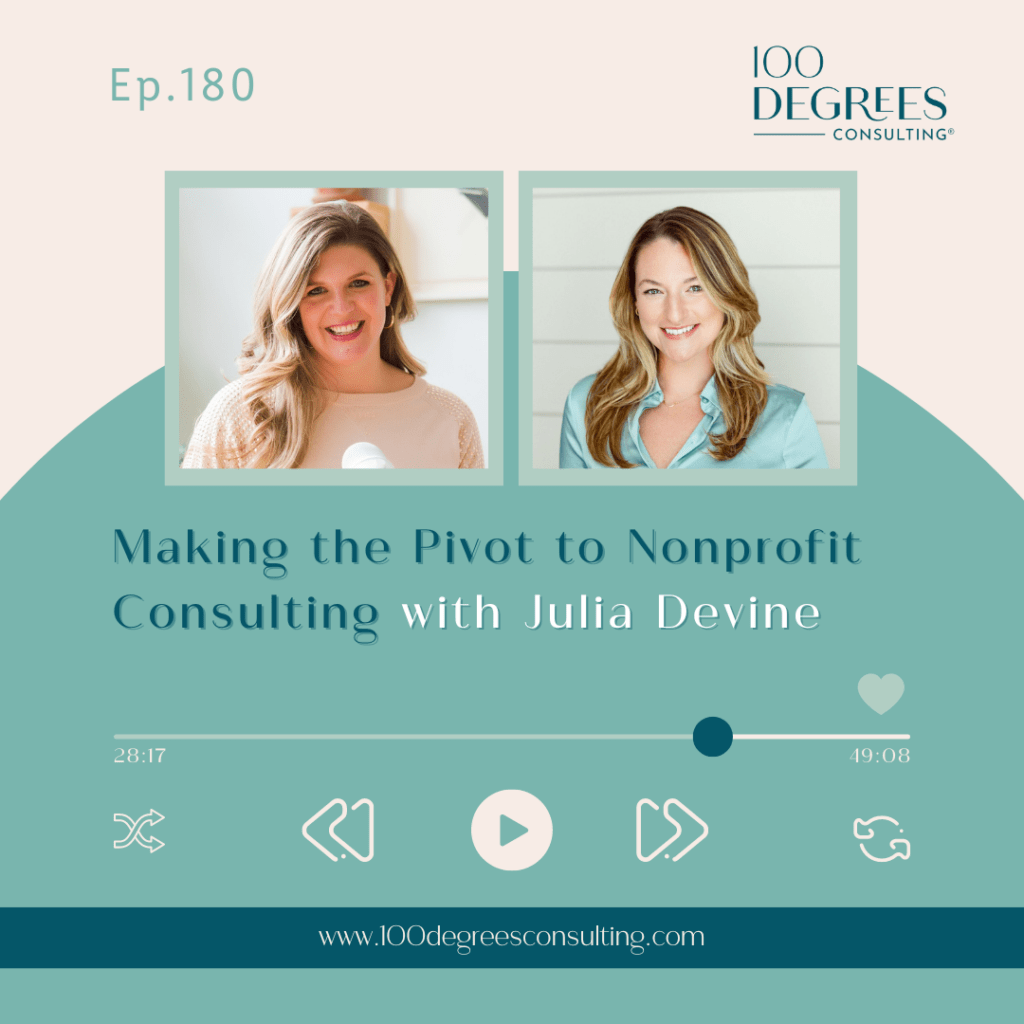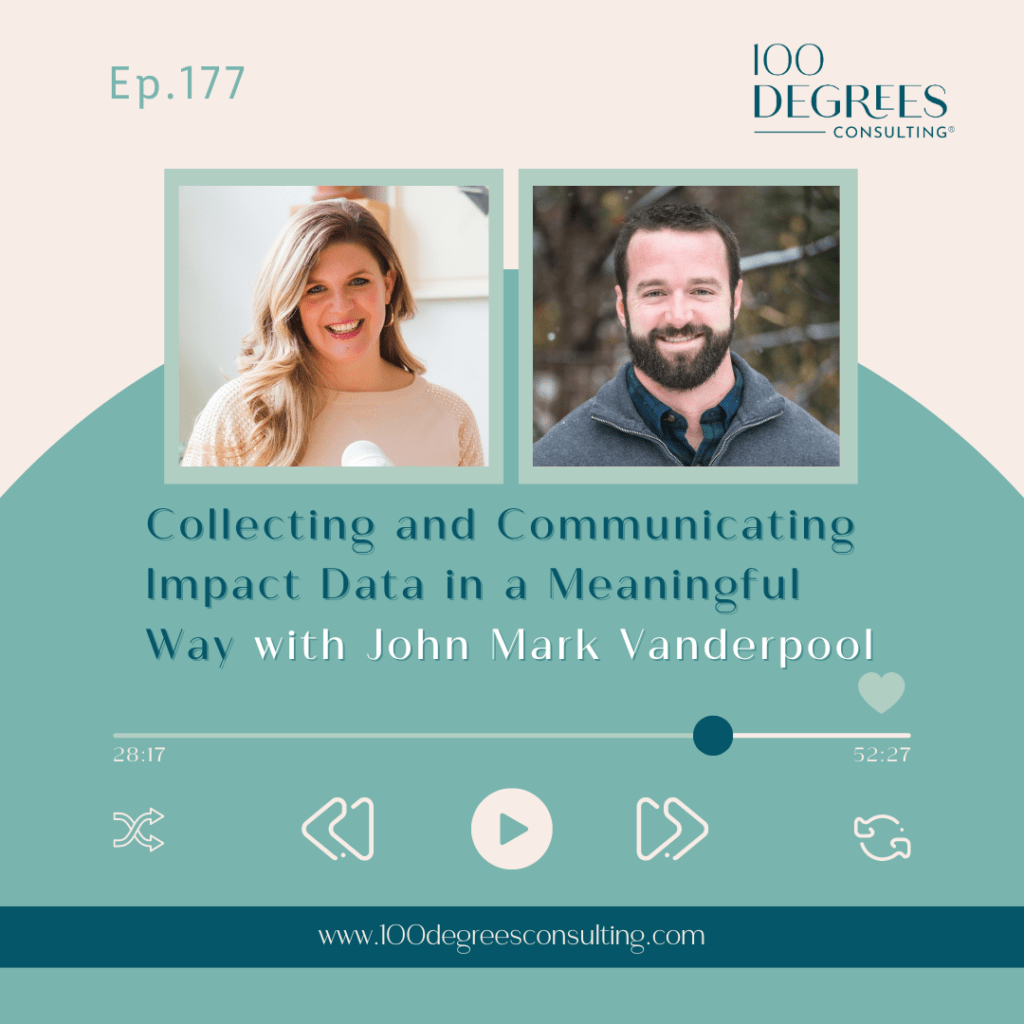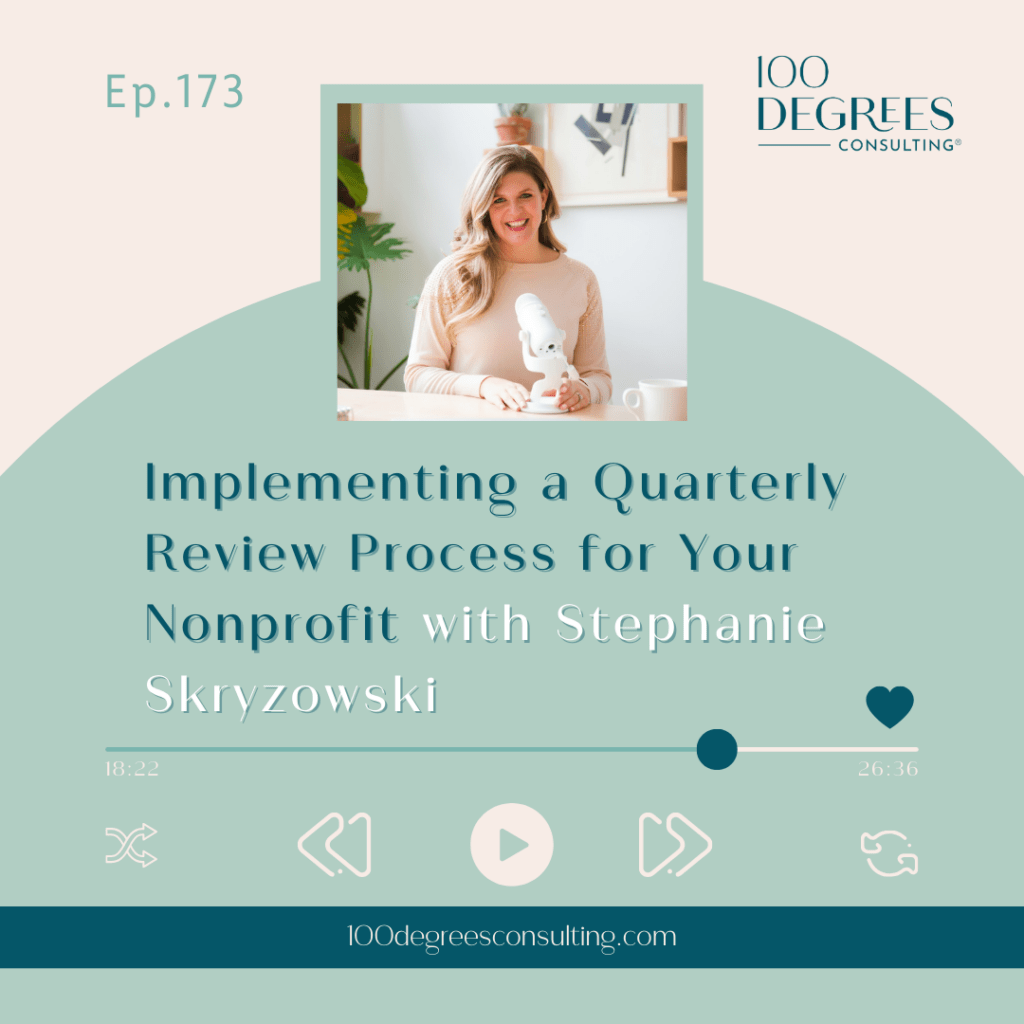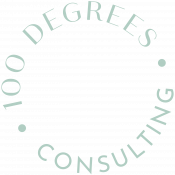Transcript Episode 133 – From Strapped to Stacked: Mastering Nonprofit Cash Flow on The Prosperous Nonprofit
Stephanie Skryzowski: [00:00:00] Welcome to the prosperous nonprofit, the podcast for leaders who are building financially sustainable and impactful nonprofits and changing the world. I’m Stephanie s Kowski, a chief financial Officer and founder, and c e o of 100 Degrees Consulting. My personal mission is to empower leaders to better understand their numbers, to grow their impact and their income.
On this show, we talk to people who are leading the nonprofit sector in new, innovative, disruptive, and entrepreneurial ways, creating organizations that fuel their lives, their hearts, and their communities. Let’s dive in.
Hi friends. Welcome back to the prosperous nonprofit. Now we have a very prosperous themed episode today talking to you about cashflow because cash, literally the [00:01:00] money coming into your bank account, the money leaving your bank account is one of the trickiest things for nonprofits. And the reason is that so much of cashflow is out of our control.
Right? That’s a tricky part when we don’t have control over something. It’s a lot harder for us to manage, to wrap our heads around and to make decisions, right? And I have found this even in my own business. And if you’re a business owner, stick with me today because this is going to be hugely important for you as well.
So I found this in my own business. Few years ago, I ended the year and I felt like it was a pretty good year, revenue wise, right? Like I felt like, oh yeah, we made a, we made a good amount of money this year. This feels good. So it was a big amount of money, revenue wise, but my bank balance looked the same at the end of the year that it did at the beginning of the year.
And I’m like, oh my gosh, what happened here? It feels like we made a lot of money. Where did it all go? Right? And that’s because I [00:02:00] wasn’t really managing my cashflow really very well, and I didn’t have a solid plan for how much money I wanted in the bank at the end of the year and create a month by month plan to figure out how to get there.
And so that’s where I was. I was like, wow, we seems like we made a lot of money, but where did it all go? And that is not a fun feeling to have. I’m thinking about another organization that was constantly struggling to make payroll, and again, they were looking at their. Income statement and they’re like, well, our revenue is solid, so why in the world does it feel so, so hard to, to make payroll?
Right? This is like a very basic expense here that we can expect every two weeks, and the problem was that they had a lot of reimbursement grants and so. They would have to shell out the cash, like significant amounts of cash, and then wait for their funders, in this case, the state government largely to [00:03:00] reimburse them.
And so there was a huge delay between the times that the expenses were incurred, right when the money went out the door from their organization. Then they had to wait for the month end to close, generate an invoice, send it off to the state, wait for the state to process it through their whole system, and then send a check.
The check goes in the mail. Finally, you get the check in the mail, you deposit it into the bank, and two days later, the cash is finally available. Right? Like that is a long period of time. And so that was a huge challenge to cashflow. Another challenge to cashflow that I’ve seen with a client was that the majority of their revenue came in October.
November and December. And so by the time August and September rolled around, they were like coasting into October 1st on fumes, like barely any money and sometimes having to draw from, you know, their vault, their savings account. That was meant never to be touched. Right. And so, We really had to figure out how to manage timing at this [00:04:00] organization so that, you know, by September 15th we weren’t down to the last few pennies in the checking account.
So there’s a lot of challenges to cashflow for nonprofit leaders to manage, and so much of the solution is really just solid planning. Solid and consistent planning, right? Having a plan that we are coming back to every single month is probably the biggest solution to this challenge. So a lot of times, like I said, some of the challenges are that there’s a mismatch between your revenue and your expenses, right?
Expenses, money going out the door happens first, and then revenue. The cash coming back in the door happens. Later irregular funding where we’re getting big chunks of money at certain periods of time, and then we’re not managing it super well, so it’s gone before it should be. And then of course, restricted funding.
Right. Maybe you have a $500,000 grant, which is [00:05:00] fantastic, and they give you all the cash upfront, which is also fantastic, but it’s restricted, right? And so we need to make sure that we’re tracking that well, so we are not spending that restricted money on something that it should not be spent on, and is very easy to do that when it’s all mixed up into the same bank account.
Hence, why your. Bookkeeping, your recordkeeping needs to be stellar so that this doesn’t happen, right? So all of these things can lead to big time cashflow challenges in your organization. And there’s nothing worse than spending your time and spending your energy and spending your brain power worried about if.
The check that you just sent to your event vendor is gonna bounce because you don’t have enough money in the bank account or because that check that you were expecting to come in hasn’t cleared yet, right? Like there’s literally nothing worse than that. So we want to free up some of our brain space to more worthy causes.[00:06:00]
And so we wanna make sure that we’re doing the right things on a weekly basis, on a monthly basis. So we’re not worried about cash, so we’re not worried about it running out. So I wanna talk today about, you know, identifying a few cash flow challenges and issues so that you can think about them in your own organization and then fix them right before they become an issue.
So the first thing I wanna think about is, Your strategic plan, do you have a plan in place for. Managing your cash. Right. Okay. So we probably have a strategic plan already. Most organizations I know do have a strategic plan, but what they don’t have is anywhere in the strategic plan. Talking about financial management, and this is such a huge part of.
The sustainability and the impact of the organization, that it’s like kind of a shocker that we don’t have anything in there about finances, so we definitely wanna make sure we have something in there [00:07:00] about our finances and for most organizations specifically something about cash. Right. Do you have a goal that you are working towards when it comes to how much operating cash you have in the bank?
Right. I love to see three to six months of operating expenses in the bank and in your operating accounts ready to tap into to use at any point in time. So that could be a great place to start, and you don’t have to have like pages and pages of a strategic plan related to financials or cash or whatever.
But I would say at least one solid goal that we are all very clear that we are working towards the same thing. So that’s the first thing. Um, that is the first cashflow issue is that we don’t have a plan. The second cashflow issue that I see is that we have a revenue rollercoaster, right? So there’s seasonality when it comes to your revenue.
So I know a ton of organizations do a lot of fundraising in Q four. Um, so that’s [00:08:00] October. November and December. A lot of their money is coming in during these months, and so what happens in March, April, may, July, right? Maybe not as much revenue is coming in then, and so we need to make sure that we are prepared to weather that dry.
Season, right? That dry spell when it comes to revenue. And so that is another huge issue, a huge challenge I see when it comes to cash. Some other things related to revenue is that you don’t have a lot of revenue diversity. So revenue is coming from one source. And maybe, you know, in the example that I mentioned in the beginning, um, maybe that revenue source is.
A government that requires, that’s a reimbursement grant where, or maybe it’s just another, you know, any other grant that’s a reimbursement grant, and so you have to shell out the cash in advance and then wait for the money to come back in. I’ve seen this with a number of organizations and that is a huge challenge when it [00:09:00] comes to revenue.
The other piece is the timing of collecting on pledges. So I work with one organization who has a ton, a ton, a ton of foundation grants. But a foundation may pledge to give you a million dollars, but then they are spreading out the cash payments of that million dollars over like the next four years, right?
So while a million dollars may look fantastic on your income statement, that is like trickling in in little dribs and drabs over the next several years. And so again, This is where having a cashflow forecast is gonna be so important. ’cause you can map that out month by month to see, okay, what is the actual true impact to our bank account of this million dollars?
It’s not as exciting as it may seem when you’re only getting, you know, $30,000 here and there over a long period of time. Right. So another, um, so that’s all revenue, right? This is all talking about [00:10:00] money coming in. Now think about money going out, right? Our expenses, our money going out obviously impacts our cash flow as well.
And what I see happening right now is that there’s a huge demand for our services as nonprofit organizations. And so we need to get money out the door quickly. But again, given the timing of money coming in, it’s really tricky. There’s often also a tough balance between fixed expenses and variable expenses.
So we often have really high fixed expenses, right? So, Think about your expenses for your people. That’s probably your biggest cost by far, is your people expense. So your people expense versus your variable expenses that are maybe tied to your program services, right? Your, like any rent or occupancy expenses are also a fixed expense.
Um, and so we have super high fixed expenses that we can’t really do anything about. So we have to make sure we have enough cash for. [00:11:00] At least payroll and paying rent and paying, um, you know, health insurance and some of those things. And so that can be tricky ’cause those expenses are really, really high.
So there’s a lot going on, right? There’s a lot that’s within our control, a lot beyond our control, but it all impacts our cash flow.
Today’s podcast episode is sponsored by Grants Works. With billions of dollars in federal grant funding available, now is the time to learn about how to apply for and manage federal grants from Patrice Davis, an expert who simplifies federal grants, her federal grants Simplified Bootcamp is a six week hybrid training that gives you the freedom to access on on-demand training on your schedule.
And to attend live weekly q and a sessions with Patrice and bonus grants Works is A C F R E approved continuing education provider. Go to [00:12:00] www.grantsworksacademy.com/federal-grants-simplified. To learn more about federal grants Simplified Bootcamp and use discount code degrees to get 10% off your registration.
And the final piece that I see as a huge challenge for nonprofits when it comes to, and actually really any organization when it comes to managing your cash. Is it your bookkeeping is not good. In fact, I have it in my little outline here. Just bad bookkeeping period, right? So what I mean by this is that your financials are not up to date.
You are probably a few months behind in your bookkeeping. Or your books are messy, you things are kind of in the wrong categories. You haven’t had a chance to fix it. And the challenge with this when our bookkeeping is not good, is that we don’t have any visibility into where things actually stand with our organization.
So, I ask this question in live sessions a lot, like [00:13:00] who manages their cashflow based on how much money is in the bank today? Like you log into Chase Bank or you log into Bank of America online and you’re like, okay, great, I have $80,000 in my bank account. I am golden, right? But what you’re not. Thinking about, and by the way, a ton of people always raise their hand when I ask that question.
Like, yes, I do this. But what you’re not thinking about is like, well, I just mailed a huge batch of checks yesterday and they just haven’t cleared yet. Like, our vendors haven’t cashed them, but when they cashed them, we’re down to like six grand in the bank, right? Or. Maybe it’s the flip side. Yeah. I just deposited like this huge batch of checks from our event that we held last week, and so that 80 grand I see in Bank of America online does not reflect that.
Right? So you’re not reflecting things that haven’t yet hit the bank, but are already out in the world. You’re also not thinking about future revenue and expenses that you have coming down the [00:14:00] road in maybe a week or two weeks or two months. Right. And so managing and making decisions based on how much cash is in the bank today, will 100% get you into trouble, right?
We absolutely don’t want to do that. We really wanna make sure that we have a forecast and that our bookkeeping is up to date. Because when your bookkeeping is up to date, that is gonna give you an idea a much better picture of your true available bank balance. So the biggest thing for me, when it comes.
To improving our cash flow, improving how much money we have in the bank is to have a plan and use a forecast, right? So if you go to 100 degrees consulting.com/cash, I have a free resource there for you. You’ve probably heard me talk about this one before, and this is solid for you, whether you are a business owner or whether you’re a nonprofit.
Um, but go to a hundred degrees consultant.com/cash. Download the template [00:15:00] because what this is going to help you do is put together a forecast. So really think through what money you have coming in, not only today, tomorrow, next week, this month, but three months from now, six months from now, 12 months from now, we should always have a rolling 12 month cash forecast to show what money is coming in, in which months.
And what money is going out in which months, right? So that will give us an estimated bank balance at the end of every single month in the future. And now if you like, if you do this and you tell me it’s not game changing for you, then I don’t even know what to say because this is game changing and I promise you, um, you’ll have so much more visibility.
Into the future of your financials and be able to make really smart decisions based on like data, right? Versus just trying to guess and hope like, Ooh, I hope [00:16:00] this check is gonna clear, right? We do not want to be in that position, and so honestly, that is the biggest game changer that I have seen for any organization is putting together a cashflow forecast.
So again, a hundred degrees consulting.com/cash. Grab the free resource. I think it’s going to be huge for you. And of course I would love to hear like how you like this, how do you use it? I wanna hear how it has helped your organization just have a better handle on your cash flow. So a couple of other things that we can think about in addition to this forecast are think about diversifying your revenue streams, right?
And maybe that is the sources from which you are getting your. Revenue, but also the months in the year. Right? So I know this is not exactly an easy thing to do, but I’m like, if you are doing all of your fundraising in Q four and you also have your annual event in Q four, I. Maybe you normally kick off a program [00:17:00] or host an event in the spring, and maybe it’s something you wanna push to the summer, right?
So there are things that you can do that don’t necessarily require like an act of God to change in your organization. And so just think about that, right? You don’t have to make any sudden and drastic changes immediately, but think about how you can possibly spread things out over time. The other thing to think about is to plan your budget strategically so that it aligns with your cash needs.
Right? And so thinking about, especially on the expense side of things, which is something we do have a little bit more control over, perhaps don’t plan for. Starting a brand new program or hiring a bunch of new people in a time when, you know, historically cashflow has been pretty low, right? So really budget strategically and plan [00:18:00] strategically for expenses to match the rhythm of your cashflow.
And all of that can be done by creating a cashflow forecast and looking at that and managing that and moving things around. When you’re seeing, oh, our bank balance in September is gonna dip pretty low, let’s not plan to hire two new employees then, right? So you can kind of move things around and see the impact that it has on your bank balance.
I think another piece of what we can do to improve our cashflow is to really strengthen our financial controls, right? Making sure that we are invoicing on a timely basis to our donors, to our funders, to reduce any payment delays, right? We wanna make sure that. We close the books in a timely fashion.
Every single month we’re invoicing who needs to be invoiced, and we are following up to make sure that cash is coming in the door. We also want to really build [00:19:00] relationships with our funders and donors so that, you know, we feel like we can reach out to them and say, Hey, you said you were gonna pay us this installment by May 1st.
It’s now June 1st, and we haven’t seen it yet, so, What can we do to speed this up? Right? It also helps, it helps to have the open communication. It helps when our, from our side, we are providing timely reports to our funders and building trust to make sure that they are, you know, they’re getting our reports on time and they’re ready to send us our money.
So having that relationship for open communication and providing them what they need on a timely basis is only gonna help everybody. So overall, there’s a lot of different things that contribute to the challenges that nonprofits see when it comes to managing cash, right? We talked about revenue and our, the money coming in the door.
There’s lots of seasonality around it. There’s restrictions. We don’t have a solid plan for managing our [00:20:00] cash and revenue is a little bit of a rollercoaster, right? So that’s one of the biggest challenges I see. The second challenge we talked about was expenses and really managing those fixed expenses versus variable expenses, and.
Often expenses just get outta control really quickly. And so it takes some intention and some planning to make sure we’re reigning them in. And then we also talked about the other challenge around bad bookkeeping, right? Not having our books updated on a regular basis, being several months behind in bookkeeping and just not being on top of the numbers and incorporating forecasting into our regular monthly routine is going to land us in a tricky place when it comes to cash.
Then on the flip side, we talked about some strategies to improve our cash flow. And the biggest thing is having and using that forecast, and I have a free tool at 100 degrees consulting.com/cash. Go grab that. That we also talked about, uh, diversifying our revenue stream, uh, reducing expenses where we can, [00:21:00] shifting the timing of.
Things around, and then making sure we’re up to date on our bookkeeping so that we are invoicing and requesting payments as soon as we possibly can, along with building relationships with our funders so that we can get the money in the door faster. So if you’re taking anything away from this episode today, I know this was another, like less on the storytelling side and much heavier on the practical.
Actionable knowledge. I hope the thing that you take away is to build a cash flow forecast. I have a template for you. You don’t have to stare at a blank Excel sheet and you know, freak out a hundred degrees consulting.com/cash. You can grab that there. So I hope my friends, I hope this episode was help to you.
Like I said, a couple episodes away. We’re doing a series of more kind of like little mini courses, right, in a period of 20 or 30 minutes to really help you grab something that you are able to implement to help build a more prosperous and sustainable nonprofit. All right, friends. [00:22:00] I will catch you next time.
It has been great being here. I hope you are all well, and I’ll see you next time on the next episode of the Prosperous Nonprofit. Bye. Hey everybody. I hope you loved this podcast episode as much as I loved recording it for you. You probably heard earlier in the show that this episode was sponsored by Grants Works, and I just wanted to pop in here and give you my 2 cents on the Federal Grants Simplified Bootcamp.
Patrice Davis is a genius at literally simplifying federal grants, which can be so scary and so confusing, but she gave me access to her bootcamp so I could check it out for myself and oh my goodness. There are just six modules. They are super simple and super clear. I love how she walked us step by step through the federal websites, which are so confusing to make sure that everything is set up right on the backend to be able to apply for federal grants.
She goes over. The application, [00:23:00] including the budget and all of the like wonky federal rules. She goes over what in the world uniform guidance means and what’s inside. Basically all of the rules that come along with federal grants. She also has this amazing federal grant application checklists and the Ultimate Grant workbook, and there’s so much info inside.
I love that I could pause. Take in the slides, take notes, and then hit play again. So I just wanted you to hear directly from me that I actually went through the bootcamp myself and it was fantastic. So the link again is www.grantsworksacademy.com/federal-grants-simplified, and that is where you can get all of the info on this amazing bootcamp.
And don’t forget to use the discount code degrees, you know, like 100 degrees consulting degrees. To get 10% off your registration. Okay, friends, this is the end of our podcast episode for today. As always, thank you so much for being here. I appreciate you [00:24:00] so much. We have our little community of loyal listeners, and I really just appreciate you.
So if you wouldn’t mind sharing this podcast with a friend, I would love it. I would love if another nonprofit leader is able to listen and get all of the information that we drop in each episode. So alright friends, I will see you next time. Bye.



















